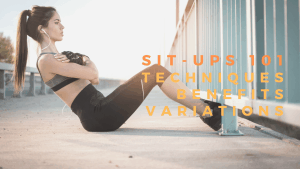What is a reverse crunch and the benefits of this exercise
Standard crunches have been proven to do little as far as toning and strengthening the abs is concerned, so if you are endlessly doing them in the hopes of getting a six-pack, then you are just wasting your time.
As a general rule, mastery of the standard form of any exercise is crucial before progressing to its more advanced variations. But the crunch is an exception to this rule. You might as well go straight for its more complex form, the reverse crunch, so you don’t lose any more precious hours exhausting yourself for nothing.
But is the reverse crunch really more effective?
What is a reverse crunch?
The reverse crunch is a core strengthening exercise that puts more emphasis on the lower abdominal region. This is a more advanced version of the classic and still highly popular abdominal crunch.
But unlike in a regular crunch where you need to lift your shoulders off the ground to contract the abdominal muscles, the reverse crunch requires you to lift your legs off the ground and towards your chest instead to hit the lower abs.
Despite the upper body remaining flat on the ground, the reverse crunch is still able to exercise the entirety of the core, specifically the rectus abdominis, transverse abdominis, and external obliques.
Doing the crunch in this position is already more beneficial than the regular crunch. Since the strain is taken off your spine and your neck remains in a neutral position during a reverse crunch, there is less flexion and force on the spinal discs, making the reverse crunch less painful for the back. It is also probably why the reverse crunch feels easier to do than the regular crunch even though it is more advanced.
Moreover, the reverse crunch hits all the superficial exterior abdominal muscles you need to achieve a sculpted six-pack, while also giving more attention to the often-neglected lower abs at the same time.
Lastly, the reverse crunch also puts your abs under tension for a longer time, maximizing all the benefits to your abdominal muscles if done properly.
So, is the reverse crunch really more effective? Absolutely.
How to do the reverse crunch
Enough with all this talk of how the reverse crunch is the better option; let’s get crunching.
- Begin by lying down with your back flat on the ground and your arms at the sides. You may keep it close to your body or fully extend them for balance, whichever is more comfortable for you.
- To get to the starting position, bend your knees and brace your core then slowly raise your legs so your knees are directly above your hips and your legs are parallel to the floor.
- Breathe out as you contract your abs to curl your hips and knees toward your chest, with only your hips coming off the ground as you curl.
- Make sure that your knees maintain the same angle during the upward phase. Also, keep your head straight, your neck relaxed, and your shoulders on the ground.
- Once you have reached the top of the movement, hold your position without letting your back come off the ground.
- Breathe in and slowly return to the starting position with your hips in contact with the ground again and your knees still bent at a 90-degree angle above your hips.
- Repeat according to your desired number of repetitions.
Benefits of the reverse crunch
Now that you know how to do the reverse crunch, here are more reasons why you should include it in your workout routine.
Focus on the lower abs
Not only are the lower abs often neglected in most abs exercises, but they are also known for being difficult to strengthen and tone. Though a six-pack is not exactly something you should prioritize, having an overall strong core is critical for optimal health, injury prevention, proper posture, and movement efficiency, which is why you must strengthen your core and that includes the lower abs as well.
Improved posture
The reverse crunch activates the transverse abdominis and other deep core muscles that are vital in maintaining a healthy posture, especially if you rarely engage in any physical activity.
Training mind and body coordination
Since the reverse crunch forces you to concentrate on contracting your core muscles and making sure they are engaged at all times throughout the exercise, it also involves some sort of mental training that establishes a connection between the brain and the body.
Safer for the neck and back
The reverse crunch does not involve any neck flexion unlike the regular crunch or any other abs exercise for that matter. People putting their hands behind their head and pushing their neck too far forward is an all too familiar sight that needs to stop because of the potential injuries it may cause to the neck and spine. This is why the reverse crunch is obviously the safer alternative.
Simple and convenient
Sure, you can always level up your reverse crunches by including resistance bands and ankle weights, but what is probably be the best thing about this exercise is that it can be performed whenever and wherever you want. The movement is relatively simple and you can do it anytime, anywhere. What’s not to like? No fancy equipment is needed; just have a comfortable mat ready and you are good to go.
Overall health boost
There is more to the reverse crunch than just toning your abs. While a well-defined stomach is impressive, there is no denying that developing a strong core is what this exercise is really about.
Moreover, reverse crunches are beneficial to everyone, but strengthening the core can be most beneficial to people who suffer from chronic back pain due to muscular imbalance and poor posture.
With the ongoing pandemic not ending anytime soon, many of us will continue working from home, further lessening mobility which means an increased risk of posture problems, back pains, and bodily injuries that may be caused by a weak and untrained core.
Reverse crunch mistakes to avoid
If you do not want to waste time just like you did when regular crunches were still part of your routine, make sure that you don’t do any of these mistakes for a more effective reverse crunch.
Relying too much on momentum
It can be tempting to turn the reverse crunch into a fast-paced exercise and use momentum to lift your legs and hips off the floor, but you must keep in mind that for this exercise to show results, contracting your abs throughout the exercise while performing each rep in a controlled manner is necessary.
Lifting the hips too far
During the upward phase of the reverse crunch, only your hips and tailbone should be off the ground. If you end up letting the rest of your back go with the upward motion, then you are already making a huge mistake. This is also another reason why it is important to keep the movement controlled; performing the reverse crunch slowly makes you less likely to go too far because you have more control than when you are using momentum and doing the exercise too fast.
Lowering the legs too far
As your legs descend to return to the starting position, avoid rolling too far and letting your knees end up in front of your hips. If you are doing the reverse crunch in a controlled manner, then you should be able to stop. But if you are using too much momentum and going too fast, you will find it difficult to control the descent and end up dropping your lower body instead.
Reverse crunch variations to try
Add some challenge to your reverse crunch by doing some of these exciting variations.
Med ball reverse crunch
Place a medicine ball between your knees and hold it there throughout the exercise. Incorporating a medicine ball will enhance the muscle-building benefits of the reverse crunch and ensure that you are performing the exercise with control.
Seated reverse crunch
Sit on a bench and lean back until your torso is at a 45-degree angle. Put your feet out in front of you and hold on to the bench for extra support. Lift your knees towards your chest then slowly lower them.
Resistance band reverse crunch
The key to a successful reverse crunch is controlled movement to keep your abs under tension at all times, but including a resistance band will further increase this tension and consequently, the toning benefits of this exercise.
Start by attaching the band at the base of a sturdy pole. Once the band is secured to the pole, loop it around your ankles to create tension as your feet reach the bottom of the movement. Now that you are all set, lift your knees towards your chest and raise your hips as you would in a regular reverse crunch, then slowly lower your hips to return to the starting position while resisting the pull of the band as your legs descend.



